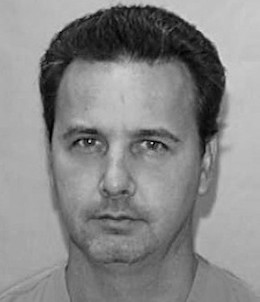How could one man conceive of committing three hundred killings? Henry Lee Lucas was probably the only serial killer whose killings had an unmistakably rational basis in his psychological upbringing. Born in 1936, this man would challenge law enforcement to prove, disprove, and prove again just which killings he was culpable for. Was Lucas making the whole thing up, or was his legal representation managing a master stroke of defense?
The childhood of Henry Lee Lucas set the stage for a violently unbalanced life and an irrational attitude towards socialization, sexuality, and crime. Yet the mind of Henry Lee Lucas would prove sharp as a tack, prompting cynical law enforcement personnel to doubt the viability of the unsolved cases. The boy who was stabbed by a brother in the eye and dressed like a girl by his mother would make the front page of American newspapers and on news bellwether “60 Minutes”.
Found guilty of the second degree murder of his mother, Lucas had been let out of prison in 1970 due to overcrowding. The visual image of Henry Lee Lucas, his face distorted by a destroyed eye, frightened a generation of awestruck Americans tantalized by his tales of triple digit killing. In an era when such killings were just beginning to make the news, the deeds of Henry Lee Lucas astonished a rapt public. Law enforcement tripped over each other trying to close cases. The television and newspaper coverage detailed double digit confessions of killings allegedly performed for no other reason than a random taste for blood.
Lucas never denied being raised in want and claimed “I hated everybody.” Despite a tendency to brag, Henry Lee Lucas was believed culpable for several dozen filed murder cases. Yet if Henry Lee Lucas was to be believed, there were hundreds more waiting to be discovered. Could the uneducated son of poor mountain people with little to no resources really kill that many people without witnesses or evidence?
People across the United States were shocked. Born August 23, 1936, and raised during the prewar depression, Henry Lee Lucas represented the gap between decent childhoods and those endured in a poverty stricken upbringing. Education and books, music and hobbies were nonexistent. The accusations that came later that Henry Lee Lucas manufactured his confessions of serial murder out of his imagination asks the question: where did he get the inspiration?
Any forensic psychological analysis begins with the childhood of the killer. Henry Lee Lucas exhibited the logical gestalt of a serial killer in young adulthood, with projected tales of strangling or sexual assault. While Henry Lee Lucas committed later murders, it is not clear how many of his confessed murders were actually performed by him. At some point his mother pursued him, and he killed her in alleged self-defense. The psychological stamp of emotional liberation with the physical act of killing was cemented.
Analysts suggest the heightened standard of living enjoyed by Henry Lee Lucas after arrest encouraged his performance as a “star” serial murder confessor. Observers of the Henry Lee Lucas phenomenon point to perks and privileges afforded this dirt-poor drifter, who became escalated to the level of a celebrity during his confessional era. Was the temptation to keep the gravy train of attention and privileges too much to shut down?
The Texas Rangers formed a Henry Lee Lucas task force to contend with the media demands and details of case files in coordination with law enforcement. One such case was the ‘Orange Socks ” killing, so named because the victim was never identified. The Investigators observed that Henry Lee Lucas had access to case files and pictures which may have led to spurious confessions.
Sexual assault and serial killing murder are not always constant companions. But Henry grew up the child of alcoholics, a silent observer of an extremely depraved family household. Confusion of ideas and perceptions as well as budding sexual emotions and physical desires took a predictable route towards sadistic pleasures. Episodic abuse piled high with imagery of violence, almost no security, and no escape fortified Henry Lee Lucas into a killer in the making.
Lucas indicated in interviews he was treated like “the dog of the family.” Little to no higher education paired with a juvenile record meant a series of road trips seasoned with episodic killings. Henry Lee Lucas would survive a brutal childhood to become possibly the most prolific serial killer America has known. But there is a cryptic matter of his verity in his confessions that blurs the legal record of his murders.
Viola and Andersen Lucas created little or no security for the child. Andrew Lucas, Henry’s brother, ended up cutting out the boy’s eye while they were playing in the yard. Henry Lee Lucas distinguished himself at school with deeds and acts that frightened other children. Lucas himself ran away at fourteen years of age. It’s possible that the signatures of serial killer incubation, arson, zoosadism, and fledgling killing were occurring at this point.
Starting with an very bad upbringing, the serial killer “recipe” was contributed to by almost every factor. Henry Lee Lucas started life growing up dirt poor in Blacksburg, West Virginia. Beaten regularly by his mother, Henry experienced brain damage. Henry lived with eight half brothers and his mother was over fifty years of age when he was born. No exaggeration of his childhood privation can be made.
By the time Lucas was of age, his messages regarding sexuality, acceptable behavior, and volition were embroidered with decades of depraved firsthand images and experiences. He may have strangled the first woman he tried to sleep with, and later experienced homosexual and bisexual periods of his life. Crime was a natural choice and by 1954, Henry Lee Lucas was committed to a psychiatric hospital after murdering a young woman.
But critics challenge that Lucas disliked his first institutional commitment. His experience outside the walls of a secure place like a hospital would make a modern dwelling and regular meals manna from heaven. Was the confession pattern merely to warrant imprisonment? One sheriff later commented that in jail, Henry Lee Lucas had “indoor plumbing and three squares a day.” The motivation to stay in prison was tangible.
Henry’s mother was a mountain woman prostitute, his paternal image a legless man who lived drunk. Henry’s father was known as “No Legs Lucas”, and his mother would entertain customers in front of the children. In contrast to this kind of life, a jailhouse existence showered with honors, attention limelight, jet trips, and media attention may have convinced Henry Lee Lucas that a serial killer’s resume could work out well for him.
Lucas fought being discharged and claimed a kill once out of the sanitarium gates. Lucas would then marry, cohabit, and stay with relatives, leaving a trail of abductions, kidnappings, molestations and assaults along the way. The Lucas lifestyle augured little work, no fixed schedule and practically no colleagues or mentors. Very few people knew of the whereabouts of this man throughout the 1960’s and 1970’s except in passing. Robbery and assault were his modus operandi.
Lucas met a man name Ottis Toole, who was even more committed to killing than he was. Ottis Toole achieved a dubious distinction in a murder career of his own. Toole and Lucas even captured a bride for Lucas after their domestic menage with Becky’s mother soured. Michigan, Texas, Pennsylvania, and more states were visited by the random violence. if Lucas is to be believed, he and Toole left the rural areas they traveled strewn with abandoned bodies and corpses.
Eventually Lucas went too far. His child bride got religion and threatened to confess one too many of his sins with her own. Staging an exit, he then faked his way back into town with a tale that Becky had left him. Becky was missed, and when her relative asked too many questions Lucas killed her as well. Observers converged around Lucas until after his arrest his interview turned up a surprise. Lucas claimed to be responsible for many, many more deaths.
The long trail of claimed murders and decades going without capture rendered Henry Lee Lucas a media celebrity. But did the prison life appeal to Lucas so much he invented the fish story of more murders, or did drugs play a role in his miraculous killing spree? Lucas was undoubtedly culpable of his mother’s death as well as Becky, who he said was, “the only girl he ever loved.”
Henry Lee Lucas had to have sex with something that was dead, and the motif for the killings as a mere “thrill” activity can be discounted. But when questions were asked of the broke drifter after the arrest, bodies started piling up. The alleged killings were random, opportunistic crimes. Lucas did not single out rich victims to rob, like the Internet Killer, or save trophies for resale, like the Green River Killer.
Found guilty of the Orange Socks killing in 1984, almost nobody could tell if Henry Lee Lucas had actually achieved a serial killer record on the basis of an extended pattern of falsification. Were there 600 killings or just over a few dozen? How many were the deeds of Lucas and not related tales from Ottis Toole? But still, Henry Lee Lucas had an undeniable history of killing people.
Questions arose out of the Lucas confessions. Did Lucas really have sexual coitus with his mother’s corpse? How much a role did the celebrity status of Henry Lee Lucas and the involvement with the media by law enforcement tainted the Lucas confessions? Just what fueled the need for a triple digit killing record of Lucas’ confessions? Over 214 killings had their case files closed. Was the recantation a legal ploy to avoid the death penalty?
June 30th 1998 was the scheduled date of the death for Henry Lee Lucas. Former U.S. President George W. Bush was Governor of Texas then. Governor Bush commuted no other sentence but the Death Row sentence of Lucas.
In 2001 in jail, Henry Lee Lucas died of heart failure. While the evidence clearly points to him murdering at least 3 people, Lucas was to take credit for and confess to more than 3000 total victims. He later recanted to a researcher stating that he wasn’t a serial killer after all. We will never know for sure.
Article by
Roy Whyte
. Visit his Google+ page for more.
 Gary Ray Bowles fits the outward ideal of – “He doesn’t look like a serial killer.” With his rather unassuming ways and almost demure manner, his mild outside appearance doesn’t accurately portray the vicious serial killer lurking within.
Gary Ray Bowles fits the outward ideal of – “He doesn’t look like a serial killer.” With his rather unassuming ways and almost demure manner, his mild outside appearance doesn’t accurately portray the vicious serial killer lurking within.





